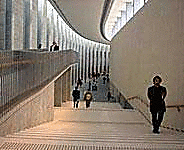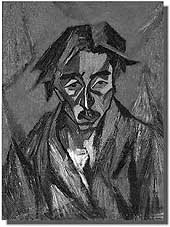Putting the regions back in the spotlight
November 7, 2001
By KATE THOMSON
Special to The Japan Times
There is cultural life thriving outside Kanto and Kansai. As proof of this, if proof were needed, the new Iwate Museum of Art in Morioka City opened to the public last month. Its core collection -- of 20th-century prints, paintings and sculptures by artists born, trained or resident in the region -- gives visitors a chance to appreciate the immense contribution of rural regions to Japan's cultural wealth.


As Hideya Sasaki, the museum's director, said in his opening address, "Growing interest in art among the residents of Iwate Prefecture led to the desire to establish a prefectural art museum as a new focal point for artistic activities in Iwate."
In 1991, an organization was set up to work toward this goal and, after a decade of preparation -- including the purchase of more artworks -- IMA was designed and purpose-built by Nihon Sekkei Co. to exhibit most of the collection in its spacious upstairs galleries.
Meanwhile, the museum's ground floor exhibition halls allow Iwate to host to host exhibitions as prestigious as its opener, "The Merzbacher Collection." A stunning private collection showing till Nov. 11, it amply demonstrates the Swiss couple Werner and Gabriele Merzbacher's love of art and the early 20th-century masters' love of life (reviewed in these pages on June 27). This exhibition also illustrates surprising aspects of, and parallels between, the major artistic figures of Fauvism, German Expressionism and Russian Constructivism. It is gratifying to see an exhibition as energizing as this in Iwate.
No less exciting is the contemporary work on show, including the installations of Tokyo-based artist Kei Tsuji (displayed in the outside courtyard and corridor gallery until March 2002).
It is the artworks belonging to the prefectural collection, however, that bring home the extent of the contribution that Iwate -- and by extension, Japan's regional provinces -- have made to Japanese art over the last 100 years.
Iwate's own collection includes a portrait bronze by Moriyoshi Naganuma, which is one of the best I have ever seen; Katsura Funakoshi's distinctive carved and painted wood portrait; fine examples of Hisashi Momose's gorgeous color-gradation prints; ceramics by Shoji Kamoda; many of Shunsuke Matsumoto's, Yasutake Funakoshi's and Tetsugoro Yorozu's best works; and more.
Yorozu is an excellent example of the importance of regional art. His work provides an insight into the crucial Japanese encounter with new European artistic directions at the beginning of the 20th century. Yorozu interpreted Impressionist, Expressionist and Cubist experiments from his own perspective, exploring the new styles in combination with traditional Western and Japanese techniques and aesthetics.
When I first saw some of Yorozu's paintings, I dismissed them as imitations of Western art. But now, seeing his work displayed alongside those of his Japanese contemporaries (the fascinating collection of drawings and paintings still at the Yorozu Tetsugoro Memorial Museum in Towa Town, a 40-minute drive from Morioka City, is also worth seeing), it is easier to understand the significance of Yorozu's place in modern Japanese art -- while the context of the Merzbacher Collection highlights both the European influences and Japanese idiosyncrasies.
As an artist, I find that living in the Iwate countryside gives me both the mental and physical space that I need to work on national and international projects and exhibitions -- although I still need to visit Tokyo regularly for the injections of multicultural energy it offers. Large cities need the regions to maintain individuality, as much as the regions need the cities to gain a global perspective.
Representing, as it does, an important statement by a prefectural government of its commitment to widening public interest in the arts, IMA will surely attract more art lovers to Iwate to experience the intensity and integrity of the regional context. As well, its visiting exhibitions give those of us who live here access to some of the global context.
* * *
As part of IMA's program of gallery talks, concerts and events, there will be a "Nandemo sodan (Open discussion)" event on Dec. 9 from 2 p.m. onward, with four Iwate-based artists in residence at the museum to meet the public. There will be designer Yoshitake Sugimoto; bronze-caster Hiroyuki Abe; printmaker Shigeki Tomura; and a stone-sculptor -- me. Visitors will be able to have a short consultation with the artists and ask questions about any aspect of art or discuss their own work (in which case, please bring some images with you).
Kate Thomson is exhibiting at the Morioka Crystal Gallery, (019) 651-6835, Dec. 8-29. Open daily 11 a.m.-6:30 p.m. (closed Tuesday). Her work can also be viewed at www.ukishima.net For more information on IMA, call (019) 658-1711; fax (019) 658-1712; e-mail info@ima.or.jp; or visit IMA's Web site at www.ima.or.jp
The Japan Times: Nov. 7, 2001
(C) All rights reserved